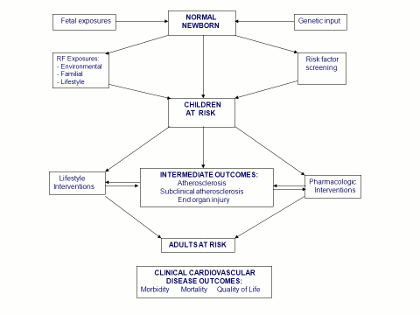Gidding - Figure 2 - Flow chart Text
As shown in this Figure, there are 2 sets of factors that impinge on a “normal” person’s life, from birth to end of life: environmental factors and genetic factors. Likewise these 2 sets of factors affect the 2 major divisions in that lifetime, childhood and adulthood, to create childhood risks and outcomes, then adult risks and outcomes. Familial hypercholesterolemia (FH) is an example of an inborn, genetic risk factor: people born with FH either totally lack functional low-density lipoprotein (LDL) receptors (homozygous FH) or partially lack them (heterozygous FH). These genetic defects will lead to serious deleterious outcomes in adulthood, but this serves to emphasize the importance of recognizing and treating this condition as early as possible in people affected with this mutation. In May 2011 the Foundation of the National Lipid Association (FNLA) published new diagnosis and treatment recommendations for physicians treating patients with inherited FH, and as the Figure suggests, the first question may be, Why is recognizing FH in children of primary importance?
J Clin Lipidol. 2011; 5(6).